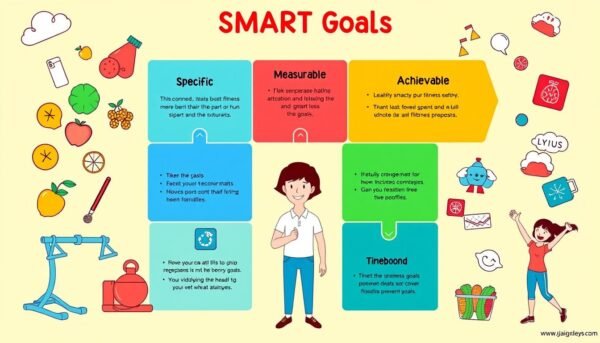As I looked in the mirror, I saw a person I didn’t recognize. The scale had gone up, and I felt tired and sore. Today, I’m ready to change and start a weight loss journey.
This journey won’t be simple, but I’m ready. I aim to lose 1-2 pounds a week for a healthier life. Losing 9-18 pounds is my first goal, which is doable for me.
To reach my goal, I’ll eat healthier and exercise regularly. I’ll burn 500-750 calories daily to lose weight. I’ll also set small goals, like walking for 30 minutes, to stay motivated.
This journey is about more than weight loss. It’s about feeling better, having more energy, and living a better life. With hard work and a focus on wellness, I’ll reach my goals and feel amazing.
Understanding SMART Weight Loss Goals

Starting my weight loss journey, I know setting SMART goals is key. SMART means Specific, Measurable, Achievable, Relevant, and Time-bound. This helps me track my progress and stay motivated.
Specific Goal Setting Techniques
I won’t aim for vague goals like “losing weight.” Instead, I’ll set specific targets. For example, I want to lose 10 pounds or eat more fruits and veggies. These clear goals guide my weight loss journey.
Measuring Progress Effectively
To see how I’m doing, I’ll use numbers like body weight and measurements. Checking these often lets me see if my lifestyle changes are working. If not, I can adjust my plan.
Setting Time-Bound Objectives
Having deadlines for my SMART goals keeps me on track. But, I’ll be flexible because everyone loses weight at their own pace. I’ll focus on making lasting changes and celebrate small wins along the way.
With SMART goals, I have a clear plan for losing weight. This method keeps me focused and motivated. It helps me reach my health and fitness goals successfully.
How to lose 50 pounds Safely and Sustainably

Losing 50 pounds is a big goal, but it’s doable. Aim to lose 1-2 pounds a week. This means you can lose 50 pounds in 7 months to 1 year.
To lose weight safely, eat fewer calories and move more. Losing weight too fast can harm your health. Always talk to a doctor before changing your diet or exercise routine.
Here are some tips for your weight loss journey:
- Focus on nutrient-dense foods: Eat whole foods like fruits, veggies, lean proteins, and grains. They keep you full and healthy.
- Establish a consistent exercise routine: Do cardio and strength training. This boosts your metabolism and burns calories.
- Set smaller, achievable milestones: Break your goal into smaller parts. This keeps you motivated and on track.
- Prioritize hydration and sleep: Drink lots of water and sleep 7-9 hours a night. These help with weight loss.
Remember, losing weight for good takes time and effort. By going slow and making healthy choices, you can lose 50 pounds safely. And you’ll be more likely to keep the weight off.
| Weight Loss Milestone | Timeline | Healthy Habits |
|---|---|---|
| Lose 10 pounds | 2-5 weeks | Morning walks, protein-rich breakfast |
| Lose 20 pounds | 4-10 weeks | Meal prepping, regular workout schedule |
| Lose 30 pounds | 6-15 weeks | Intermittent fasting, strength training |
| Lose 40 pounds | 8-20 weeks | Tracking progress, adjusting goals |
| Lose 50 pounds | 10-25 weeks | Maintaining healthy habits, seeking support |
Creating a Realistic Weight Loss Timeline

Starting a weight loss journey is exciting but also tough. Losing 50 pounds needs a good plan to keep you going. It’s all about being patient, consistent, and making lasting lifestyle changes.
Short-term Milestone Planning
Studies say aim to lose 5% to 10% of your weight in the first 6 months. This means losing 1 to 2 pounds a week, which is healthy. Breaking your goal into smaller steps helps you stay on track and celebrate your wins.
Long-term Success Strategies
Early on, you might lose weight faster. But, focus on building habits that last. Eat fewer calories and exercise regularly. Aim for a 500-calorie cut each day to lose about 1 pound a week.
Adjusting Goals as You Progress
Weight loss is different for everyone. As you go, you might need to change your plans. Be open to adjusting your goals based on your body and life changes. The goal is to keep healthy habits for life, not just to meet a deadline.
Developing a Sustainable Calorie Deficit

Starting a healthy weight loss journey means creating a calorie deficit. Aim to eat 500-750 fewer calories each day. This can help you lose 1-2 pounds weekly. Choose low-calorie, nutritious foods to stay full and eat less.
Adding regular exercise is key to burning more calories. Use tools like the USDA’s MyPlate or nutrition apps to track your calories. This ensures you eat a balanced diet. Remember, your calorie needs change based on your age, gender, weight, and how active you are.
| Calorie Deficit Guidelines | Recommended Intake |
|---|---|
| Women and those assigned female at birth | 1,200 to 1,500 calories per day |
| Men and those assigned male at birth | 1,500 to 1,800 calories per day |
Creating a sustainable calorie deficit helps you reach your weight loss goals healthily. Mix eating fewer calories with regular exercise for a successful sustainable weight loss journey.
Building Healthy Eating Habits for Weight Loss

Weight loss isn’t just about counting calories. It’s about making healthy habits that last. Focus on portion control, meal planning, and nutritional balance. This way, you can live a lifestyle that helps you lose weight.
Portion Control Strategies
Controlling your portions is key to healthy eating for weight loss. Use smaller plates and measure your food. Listen to your hunger and fullness cues. Practicing portion control can help you feel satisfied without consuming excess calories.
Meal Planning Fundamentals
Planning your meals ahead can greatly impact your weight loss. Create a weekly meal plan with foods like lean proteins, whole grains, fruits, and vegetables. This helps you avoid unhealthy choices and ensures a balanced diet.
Nutritional Balance Tips
- Aim for a balanced plate with lean proteins, complex carbohydrates, and healthy fats at each meal.
- Incorporate a wide range of fruits and vegetables to get a variety of essential vitamins and minerals.
- Limit your intake of processed foods, added sugars, and high-fat items that can sabotage your weight loss efforts.
- Stay hydrated by drinking plenty of water throughout the day.
By developing these healthy eating habits, you’ll be well on your way to sustainable weight loss and a healthier lifestyle. Remember, consistency and patience are key when it comes to making lasting changes to your diet.
Incorporating Exercise into Your Weight Loss Journey

Regular physical activity is key for losing weight. I aim for 150 minutes of moderate exercise or 75 minutes of vigorous exercise weekly. This has really helped.
I also do strength training twice a week. It builds muscle and boosts my metabolism. Plus, I enjoy the activities I do, which keeps me going.
I started with small steps and slowly got more intense. I also try to move more each day. Like taking the stairs or parking far away.
Sticking to my exercise routine has changed my life. It’s made me healthier and helped me lose weight. Finding fun activities keeps me motivated.
Tracking Progress and Making Adjustments

Reaching your weight loss goals is a journey. It’s important to track your progress regularly. This keeps you motivated and helps you make the right changes.
Using Digital Tools and Apps
Use digital tools and apps like Healthi or MyPlate to track your food, exercise, and weight. These tools help you see if you’re meeting your calorie needs and nutrient goals. Logging your data regularly helps you spot patterns and adjust your diet and workout routine.
Taking Body Measurements
Take body measurements like waist, hips, and thighs, not just your weight. These measurements give a fuller picture of your progress. They help you celebrate small victories, like better body shape and fitting clothes.
Adjusting Goals When Needed
Be ready to change your goals as you go. Weight loss can slow down, and you need to be flexible. Celebrate your wins and don’t get down about temporary stops. Keep moving forward and be open to making changes for more progress.
| Metric | Frequency | Measurement |
|---|---|---|
| Weight | Daily | Weigh yourself upon waking, after going to the toilet, and note the weekly average. |
| Body Measurements | Weekly | Take measurements to the nearest 0.1 cm at nine places, once per week. |
| Progress Photos | Every 4 weeks | Take front and side photos using the same conditions for consistency. |
| Dietary Adherence | Weekly | Rate your weekly dietary adherence as a percentage of total calories for the week. |
By tracking your progress and making adjustments, you’ll reach your weight loss goals. The journey is key, so celebrate your wins and keep working towards your health goals.
Overcoming Weight Loss Plateaus

Hitting a weight loss plateau can be really frustrating. But, it’s a common part of getting healthier. There are ways to get past these plateaus and start burning fat again.
First, check your calorie intake and how much you burn. As you lose weight, your body might need more or less energy. Don’t cut calories too much, as it can slow your metabolism. Instead, try to burn more calories by being more active.
- Try new exercises or make your workouts harder. This can help your metabolism and get you past the plateau.
- Make sure you sleep well and manage stress. Both can affect your weight loss plateau and fat burning efforts.
- Think about changing what you eat or when you eat it. This might help you start losing weight again.
Remember, being consistent is important. Keep up with your healthy habits. Weight loss plateaus are normal, and with some changes, you can get past them and keep moving forward.
| Tip | Benefit |
|---|---|
| Increase exercise intensity | Boost metabolism and challenge the body |
| Ensure adequate sleep and stress management | Support overall weight loss efforts |
| Adjust macronutrient balance or meal timing | Kickstart progress and break through plateaus |
Mental Preparation for Long-term Success

Long-term weight loss is more than just losing weight. It’s a mental journey too. Having a growth mindset is key for lasting success. Instead of focusing on the scale, think about the health perks like more energy and better mood.
Being kind to yourself is important. Don’t be too hard on yourself and celebrate small wins. When you face setbacks, see them as chances to learn, not as failures. Find healthy ways to deal with stress and emotions.
Setting goals that aren’t just about weight can keep you motivated. Imagine how your life will change for the better. Be ready for tough times and stay flexible with your plans. With the right mental preparation, you can reach long-term success and make lifestyle changes that stick.
| Strategies for Mental Preparation | Benefits |
|---|---|
| Develop a growth mindset | Embrace challenges as opportunities for learning and improvement |
| Practice self-compassion | Avoid negative self-talk and celebrate small victories |
| Set non-weight related goals | Maintain motivation beyond the number on the scale |
| Visualize success | Envision the positive changes in your life and lifestyle |
| Prepare for setbacks | View them as learning opportunities, not failures |
Building a Support System for Weight Loss
Starting my weight loss journey, I learned how important a strong support system is. My family and friends have been a big help. They keep me motivated and on track.
They share healthy recipes, go to the gym with me, and check on my progress. Their support is priceless.
I also joined weight loss support groups online and in-person. These groups are a safe place to share and learn. We celebrate each other’s wins and help with challenges.
Working with a registered dietitian and a personal trainer has been a game-changer. They helped me create a healthy plan. Their guidance keeps me focused and moving forward.
This post may contain affiliate links which means I may receive a commission for purchases made through links. I will only recommend products that I have personally used! Learn more on my Private Policy page.